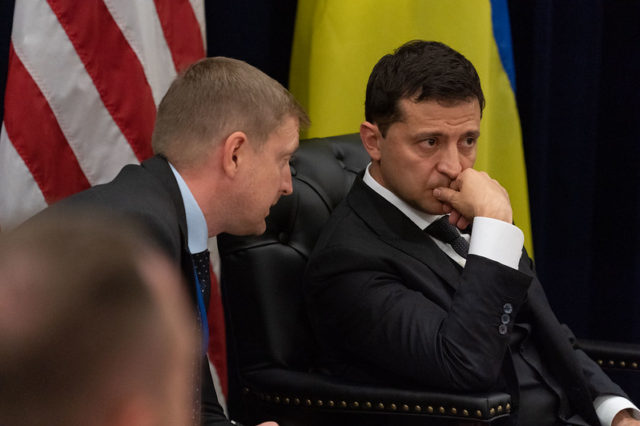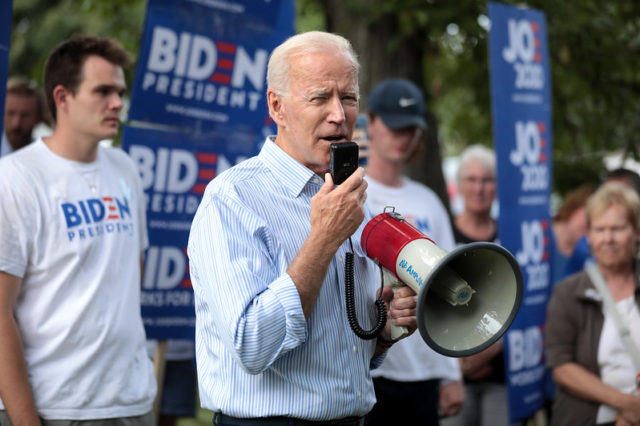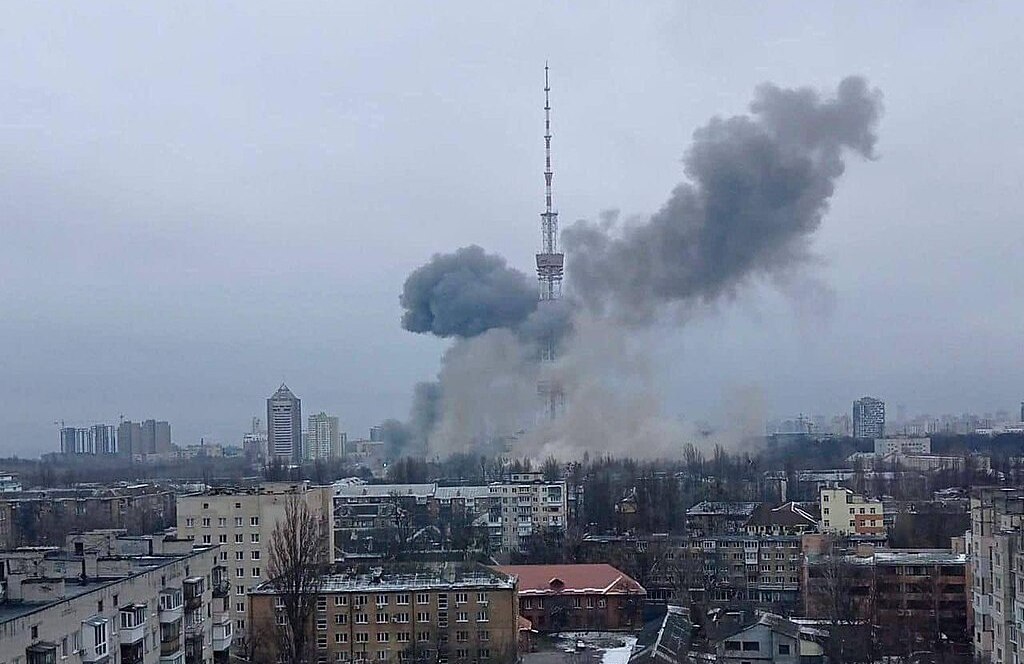By definition, a constant cannot explain a variable. If we want to explain why this is happening now, we need to look at the factors that have changed at all levels of analysis: the individual, the national, and the global.
The cast of characters
At the individual level, Vladimir Putin is a constant. He’s a trained officer of the old Soviet KGB who sees the world from that perspective: a zero-sum game, Russia is both a great power and a victim of encirclement, and laws are something to ignore when they get in the way. His personal goal is his own power; his policy goal is the restoration of the Russian Empire. He has consistently held that the Ukrainians are not in fact an independent people, but part of greater Russia. All of this has helped to motivate a long series of operations to keep Ukraine in the Russian sphere of influence, launch the 2014 military occupation of Crimea, and support the breakaway regions in Ukrainian districts of Donetsk and Luhansk.
What it does not do is provide an immediate motive for an invasion to occupy Ukraine. What Russia is doing now is a high-risk move. And while Putin’s KGB recruitment file describes him as serious and reliable, it does not describe him as someone who is prone to make this kind of a commitment if more limited tools are available.

In Ukraine, Volodymyr Zelenskyy is a political outsider elected in 2019 with over 73 percent of the vote after playing the role of president of Ukraine in a popular TV show. He continued the post-2014 trend by pushing anti-corruption, pro-EU, and pro-NATO positions. He was the subject of a December coup attempt and one of his best friends has narrowly escaped assassination.
A third individual to consider is President Joe Biden of the United States. Like Ukraine in 2014, the US has had a remarkable transition. His predecessor, Donald Trump, had limited foreign policy expertise, an “America first” ideology verging on isolationism, and condemned the North Atlantic Treaty Organization (NATO) as “obsolete.” He demonstrated an admiration for the Russian leader, including willingness to accept Putin’s reassurances in 2018 over the reports of his own intelligence agencies. Joe Biden, on the other hand, is the past chair of the US Senate’s Foreign Relations Committee, where he established a reputation as a liberal internationalist in foreign policy. He supported the admission of former members of the Warsaw Pact and Baltic republics into NATO. Biden is committed to the policies associated with Franklin Roosevelt: domestic reform, a defense of democracy, and involvement in international institutions. He is an expert in building and using alliances.
The national and international context
Leaders are important but they are shaped by their national circumstances. Zelenskyy is in power because the majority of Ukrainians already wish to join the West. Biden is in power because a majority of Americans preferred him to Trump. In democracies, the freedom of action of a leader is constrained by the support he can build for his policies at home as much as his power abroad, but presidents are less constrained than a prime minister in a parliamentary system. Even in autocracies a lack of public support can make policy more difficult to maintain.
The United States is a constitutional federal republic in which the president is elected through an electoral college system, modified by a complex system of federal and state laws that allows a politician supported by a minority of the voters to win the presidency (as in 2000 and 2016) or a disgruntled politician to attempt to overcome the popular vote to keep himself in power (as in 2020). Its electoral system rests on a set of norms among people who value stability and democracy. It is vulnerable to outsiders not dedicated to those norms. The United States is also a huge, complex, multiracial, and inequitable society, which opens fissures that can be exploited.
Trump was supported, openly and covertly, by Russia. This low-risk, low-cost operation succeeded beyond all expectations so, while Russia lost a partner in Ukraine in 2014, it gained one in America in 2016. The damage Trump did in his first term was limited by his unfamiliarity with the details of governance and the professionalism of the bureaucracy. Given the advantages of incumbency Putin expected his ally to win a second term, in which Trump would continue to weaken the capabilities of the US and Europe. All Putin had to do is sit back and collect the rewards.
But Trump lost. Biden began to improve America’s image and restore its ties to allies. One of the world’s largest economies (first in GDP, second in PPP) and the most powerful military on earth, the US grew active in pursuing a pro-democracy and internationalist agenda. Today, every day Biden remains in power means Putin is losing in relation to the US and its NATO allies.

In Ukraine, the government is a semi-presidential unitary republic. The day after Zelenskyy took office, he called for a snap election that filled the parliament with his supporters — 80 percent new to the parliament, and 61 percent people who had never run for any office before — producing a one-party majority. While some pro-Russian ministers remain, they are only 43 members of the 450-member Rada.
Even more than in the United States, a tolerable condition — typical politicians who were looking for personal deals and gave a voice to Russian nationalists — was replaced overnight with a government that was a disaster for Russia and Putin. As noted, Putin attempted to apply the usual tools to bring Ukraine into line — bribery, threats, assassination, a coup — without success. Every day Zelenskyy remains visible and in command, Putin is losing.
Ukraine maintains forces to keep its independence. While it chose to sacrifice its nuclear weapons for a formal pledge to protect its territorial integrity it retains a conventional military ranked 22nd on earth, superior to Poland, Canada, or Sweden. A Ukrainian military will never be a pushover. And if Russia does eventually conquer Ukraine, it would find the country impossible to hold, much like the US found it impossible to rule Iraq. If Ukraine were to join NATO, that would make the costs of war prohibitive.
The Russian Federation has the form of a semi-presidential federation with multiple parties. In practice, it has experienced democratic decay and become an authoritarian state. Alternatives to Putin’s United Russia party exist but they have not been permitted to share in power. In the 2021 election to the Duma, it maintained a super-majority despite polling indicating only 30% support from the Russian people. United Russia claims to be the heir to Russia’s traditions, guiding a “sovereign democracy.” Putin has consolidated his personal power through constitutional amendments extending his potential term in office to 2036 (when he will be 84 years old), exceeding that of Joseph Stalin.
Putin’s tenure, like Russia’s status, is more fragile than it appears.
In contrast to the internal consolidation, the trends for Russian power internationally are not favorable. At one time an unquestioned superpower, Russia remains a great power on the basis of its enormous oil and natural gas reserves, the world’s largest nuclear weapons stockpile, and the second-largest military in the world. But its natural resources are 60% of its GDP. Russia is commodity-dependent. In a sense, it is a gas station with an army. Putin is aware that even an authoritarian must continue to deliver the goods – to the oligarchs, the military, the security services, and the population. Putin’s tenure, like Russia’s status, is more fragile than it appears.
So why now?
We finally have an answer to the question “why now?” Putin has seen things going his way for a long time and expected it to continue. He also excludes anyone from his bubble who tells him what he doesn’t want to hear. He expected Trump to win (or steal) the 2020 election, providing four more years to undermine NATO and Ukraine. Biden’s victory wrecked that plan. So, Putin turned to his other tools; they failed. Now, as Ukraine grows more united and more inclined to integrate itself into Europe, Putin fears he’s running out of options. He believes his lies about Ukrainian identity, he’s dedicated to restoring the Russian Empire, and he’s watching the window closing.
Hence, he’s convinced himself to take the big gamble.
The closest historical parallel may be Japan in 1941. Japanese strategists didn’t think it could beat a fully mobilized United States, but they hoped a shock would lead to a surrender or disengagement that would release Japan from the stranglehold it was in. When you are desperate, you may take “irrational” risks that can explode in your face.
The price of arrogance
Explode they have. NATO is more unified than ever. For the first time, a mobilization of NATO forces has been declared. Joe Biden has announced the release of $350 million dollars in military aid to Ukraine, Germany has announced it will raise its military budget and deliver 1000 anti-tank weapons and 500 Stinger missiles. Chancellor Scholz has also decertified the Nord Stream 2 gas pipeline and begun construction of new LNG terminals to end dependency on Russia. The European Union, for the first time in its history, has decided to “finance the purchase and delivery of weapons and equipment to a country under attack.”
The removal of Russian banks from the SWIFT international banking system, a “just short of nuclear” financial option once considered too expensive for European support, is now being implemented. Japan is joining in a boycott of Russian banks, including the Central Bank of Russia, the Russian Federation’s version of the Bank of England. The Ruble is in free fall.
Putin continues to be desperate. He has ordered Russia’s nuclear forces to “a special regime of duty” in response to foreign sanctions, after 643 billion dollars were blocked from Russian Central bank accounts in New York, Frankfurt, and London. He’s also lost control of the narrative. TASS, the Russian news agency, reported that by the third day of fighting, 4300 Russian soldiers had died. The most likely Russian puppet in case of a takeover, Ukrainian oligarch Viktor Medvedchuk, has fled to Belarus. Russian people have joined those in Europe protesting the invasion.
While Russia has taken some territory, it is much less than anticipated. The Ukrainians fight with a ferocity Putin never imagined. In Kharkiv, Ukraine’s second largest city, Ukrainian troops have expelled the Russians. Russian troops continue to face stiff resistance outside of Kyiv, a capitol they expected to be holding by now.
The fight is here; I need anti-tank ammo, not a ride.
The war is not over. The fog of war means we should question everything. But clearly, Russia’s operations have not been going according to plan. According to a senior Pentagon official, as of now Russia has committed two-thirds of its forces to the fight in Ukraine and fired over 320 missiles without holding a major population center for its actions.
Perhaps the most telling evidence of the situation on the ground came when America offered to airlift President Zelenskyy to safety. His reply: “The fight is here; I need anti-tank ammo, not a ride.”
Individual sanctions placed on the Russian leader and his supporters hurt them in their wallets and undermine support for Putin among those who have enriched themselves under his rule. It is now conceivable that some of the people who keep Putin in power will conclude that his continued rule is no longer worth the cost.
Ironically, Russia’s invasion of Ukraine is the act of a desperate man who convinced himself of his own lies and through bold, decisive action brought about that which he most fears.
Image credits: President of Ukraine, Gage Skidmore and mvs.gov.ua

